In 2019, Star Wars Jedi: Fallen Order arrived loaded with promise. After years of microtransaction-heavy multiplayer games, EA was finally delivering a cinematic single-player Star Wars experience. Sure, there were some technical hiccups along the way and a smattering of odd design decisions, but fans assumed that developer Respawn Entertainment had paid attention and that Cal Kestis’ next adventure would arrive polished to a mirror sheen.
Enter Star Wars Jedi: Survivor. The sequel picks up five years after Fallen Order, with a more experienced (and more bearded) Cal running missions for Saw Gerrera. The Empire must fall, though as the story is set nine years before A New Hope, Cal is fighting it at the height of its powers, and true victory feels like wishful thinking. But perhaps an ancient galactic mystery might provide a haven from their watchful eyes…
I won’t reveal any more of the plot, though it’s filled with familiar faces from the last game along with some fun new characters. The writers also recognize that canon constraints mean Cal can never blow up the Death Star or defeat Darth Vader, instead leaning into a surprisingly personal and smaller-scale story that’s more about character relationships than moon-sized space stations going kaboom.
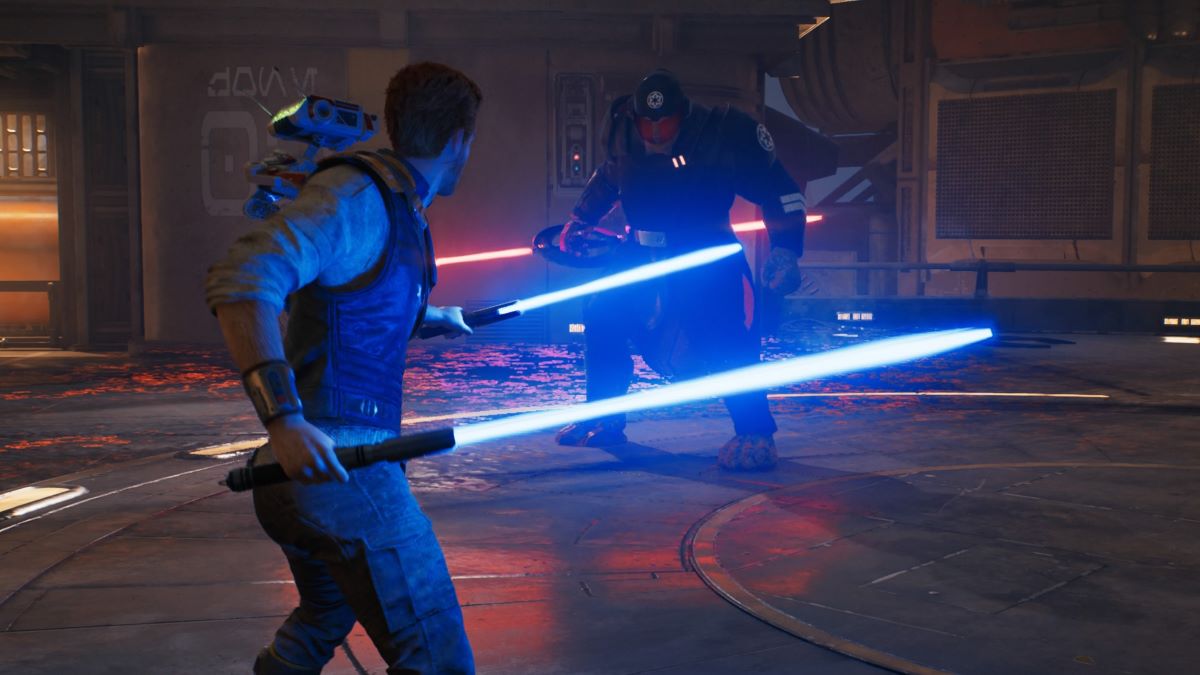
I also suspect Survivor‘s gameplay is going to go down even better with gamers this time around. Survivor, like Fallen Order, is Dark Souls-adjacent, lifting elements like losing XP on death and having a single chance to recover it, bonfires (read: meditation points) where resting will also respawn enemies, and limited heals per run. In 2019, the Soulslike genre had an intimidating reputation, but we’re now one year out from the smash-hit Elden Ring, and with more than 20 million copies of that game sold, many more players will have the confidence to tackle this.
That said, it’s safe to say that Survivor isn’t going to be troubling anyone who’s rolled credits on Elden Ring. If anything, the default difficulty has been ever so slightly dialed back from Fallen Order, with even the final bosses in the game going down in two or three attempts. That may be down to the game’s combat expanding from two to five lightsaber stances, giving you more options in how you want to approach enemies. Lifted straight from Fallen Order are single and double-bladed stances, while twin blade is now a fully realized stance rather than a special move. The crossguard (aka Kylo Ren style) and blaster stance are brand new.
Sadly, in an annoying restriction, you can only equip two of these five stances at any one time and, given that your bread ‘n’ butter single-blade is useful in every scenario the game throws at you, it makes sense for that to occupy a slot for the entirety of the game.
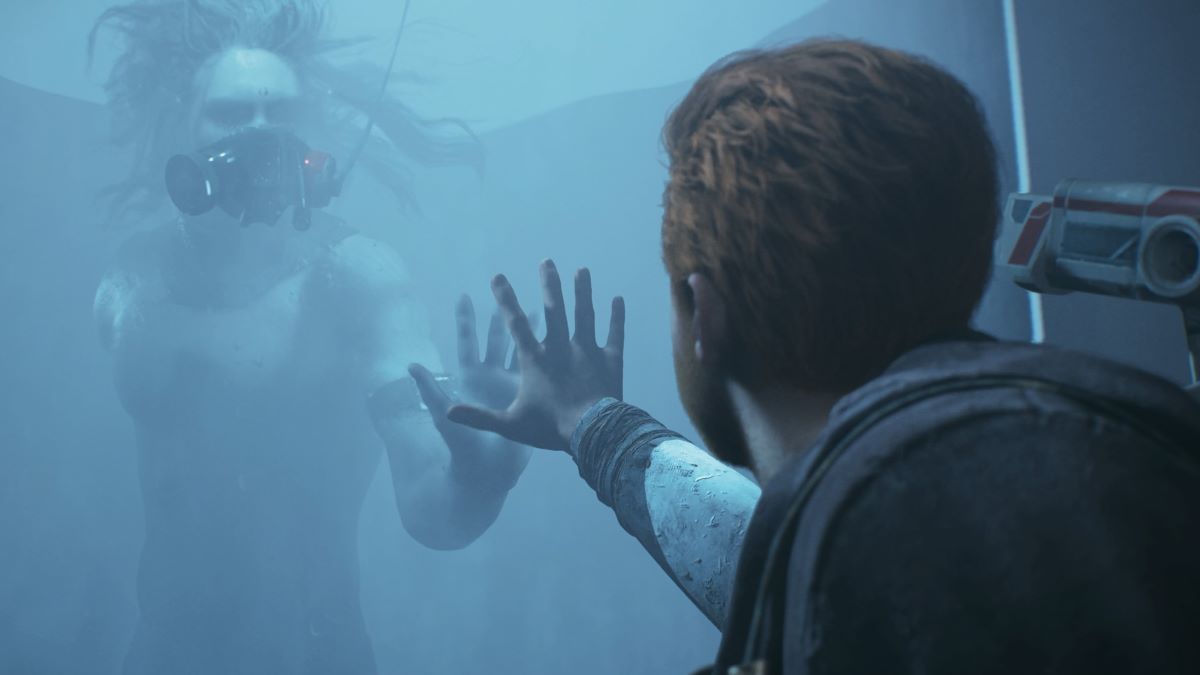
Unfortunately, the new blaster stance is almost redundant (though it sure looks cool) and I couldn’t find a reason to pour valuable stat points into upgrading it. Even without a gun, Cal has multiple ranged options via his Force abilities and by deflecting enemy projectiles. Since Jedi: Survivor‘s most dangerous enemies are melee-focused, you’ll end up using your saber anyway, and as a result, any of the other four stances end up being a better option.
And then there’s crossguard. Lovely lovely crossguard… This particular stance turns your lightsaber into a hard-hitting broadsword and it quickly became my go-to stance for bosses, as its charged attack generally knocks them to the floor and lets you follow up with another powerful charged attack. My philosophy is that a shorter fight is an easier fight, so turning Cal into a glass cannon worked for me.
Survivor is at its best in the one-on-one saber duels that punctuate the game, where carefully parrying your opponent’s blows, staggering them, and then following up with your own combo feels like a tightly choreographed scene from the movies. I also loved that there’s (non-gory) dismemberment of enemies, which helps make the lightsaber feel more like a deadly weapon and less like a fluorescent baseball bat.
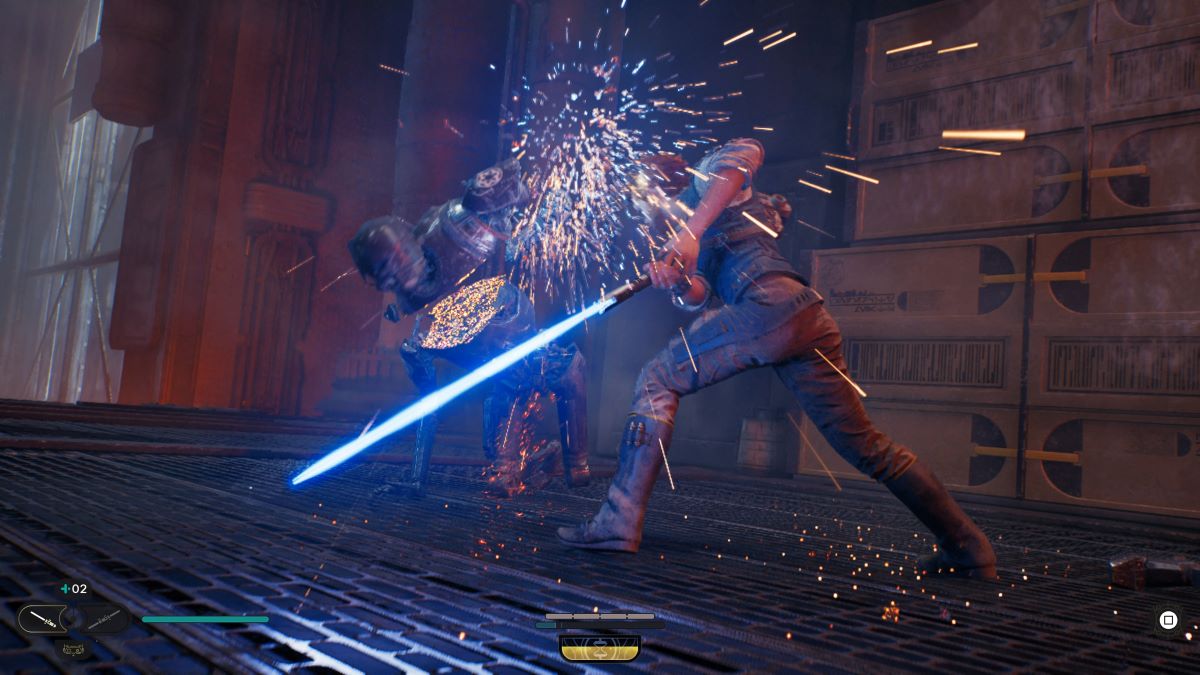
Also impressive is the frequent platforming, which sees Cal wall-running, climbing, flipping, and boosting between panels suspended high in the air. There’s a mild penalty for falling, but nailing a particularly tricky acrobatic sequence underlines how superhuman a Jedi is compared to the average mook. I also appreciate that Survivor has much less hand-holding in traversal and exploration than other games, meaning you’re not blindly following a trail of yellow paint and scenery through the levels. There’s also a lot of lore tucked away in corners, with the post-game going on to include fresh information that sheds new light on the plot.
On top of that, there’s a smattering of side content that’s not mandatory, though very much welcome. If you have time for only one, make sure you complete the bounty hunter side missions, which boast some tricky boss fights and occasionally rework existing areas with new enemy layouts.
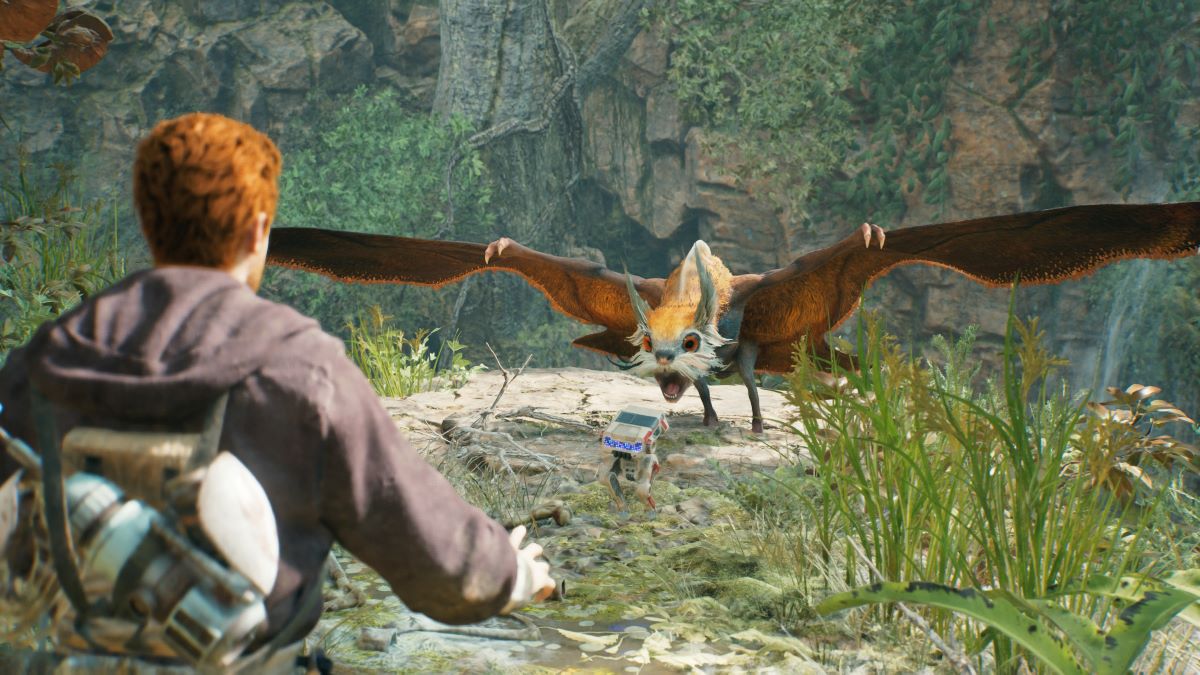
All the above makes for a thrilling action experience with a lot of memorable moments. But, depressingly, there’s also a whole bunch of stuff that’s not so great.
Fallen Order featured expansive planets to explore, though Survivor settles on two open worlds interspersed with shorter, more linear levels. The majority of the game is set on the planet Koboh, which boasts a large assortment of biomes, though the lack of other planets to travel to makes Survivor‘s galaxy feel smaller than Fallen Order‘s. However, we do love that there’s now a fast travel system, squashing the tedious Fallen Order problem of having to painstakingly retrace your steps back to your ship once you’ve completed your objective.
More seriously, Survivor is riddled with graphical and performance shortcomings that can’t be ignored. I played through the game on PlayStation 5, which comes with a quality setting that aims for 4K at 30 FPS, and a performance mode at 1440p that targets 60 FPS (“targets” being the operative word). I dabbled with the quality mode, but the timing and reaction-based combat simply didn’t feel responsive enough at 30 FPS, not to mention there were still frequent stutters and frame time spikes that took the action down into the 20s.

Performance mode plays better, but it also looks substantially worse. Although it outputs a 1440p image, the internal resolution appears to go much lower to maintain the framerate, resulting in a grainy and blurry image with offputting smears behind characters as they move. Worse, while it targets 60 FPS, it frequently falls short of that. Combat-focused sections and boss encounters see the game perform best, but in areas populated by NPCs, Survivor drops frames all over the place. There’s also some loading that feels distinctly last-gen — the saloon in Koboh will have you impatiently waiting for its doors to open as the game frantically loads the busy environment into memory.
Beyond that, there’s a smattering of small glitches, like Cal hovering a few inches above the ground, his cape jittering around him, his body clipping through scenery, his hair not being lit properly, enemies not reacting to his presence, lighting being visibly built around environments as they load, and strange black smudges where textures have failed to load.
The version sent to us for review received a Day 0 patch on April 25, though this doesn’t appear to have resolved these issues. There will also be a further Day 1 patch on release, so perhaps some of these issues will be addressed there (though at this late stage, I have my doubts). Even if they are fixed, this version is what EA and Respawn sent out to reviewers as the “final build,” so I feel duty-bound to mention them.
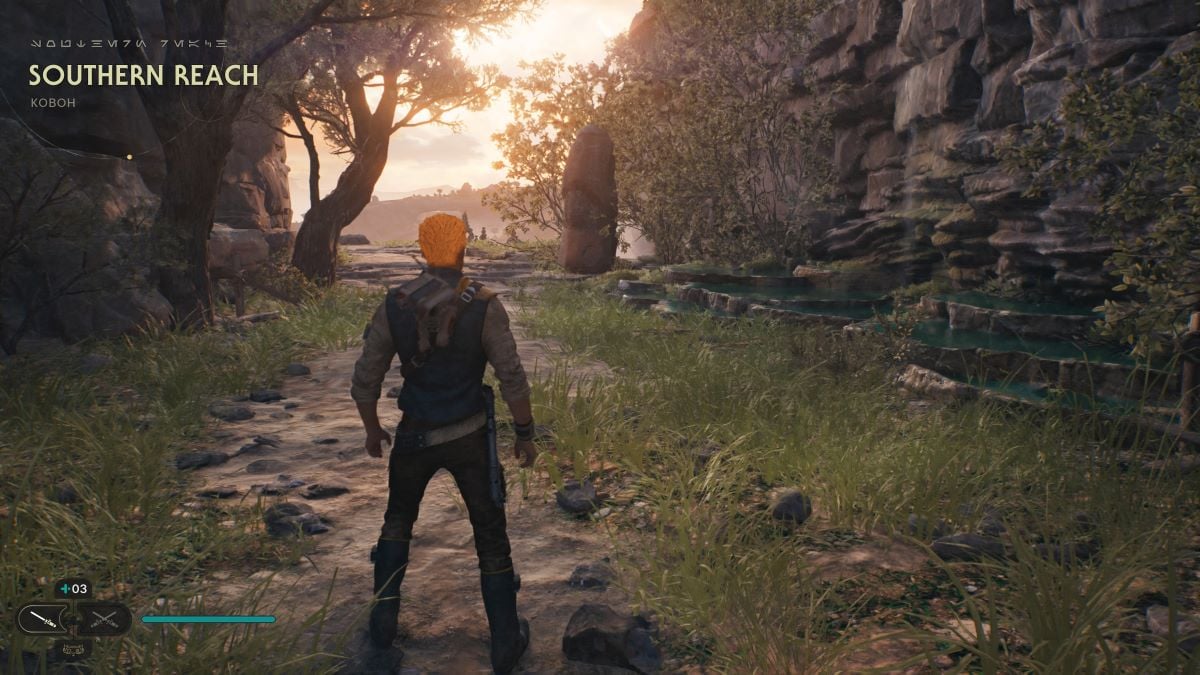
One other mild annoyance is that Survivor‘s controls map attacks to the face buttons and Force moves to the shoulder buttons. I’ve spent so much time playing Elden Ring (and other Souls games) that my muscle memory is geared to their controller configuration. In Fallen Order, it was straightforward enough to remap the controls to be more Souls-like, though when I tried to change them to a more Souls-like setup in Survivor, I hit the snag of being unable to reassign a single button to two inputs.
For example, on default controls R1 is used for the ‘focus’ ability, to order allies to attack and to summon mounts, so rebinding R1 to be just light attack means you lose one of those functions. Beyond that, rebinding appears to break blaster stance functionality as the gun can’t be triggered by R2. In the end, I gave up and used the default controls, which never felt quite right.
Survivor is a good-looking game, though it doesn’t push graphical boundaries beyond what we’ve seen from other PlayStation 5 games, and it isn’t a quantum leap from Fallen Order. I’m not entirely sure why an Unreal Engine 4 game from a developer as talented as Respawn and a publisher with as many resources as EA is in this state, but let’s just say the late delay from February to April now makes sense. Considering how it plays now, I can only imagine what it was like two months ago.
Like Fallen Order, I’m sure Survivor will eventually be running much more smoothly after a few rounds of patches, but, depressingly, this looks to be yet another case of day-one customers getting the worst experience.
There’s so much to like about Survivor: I had a blast exploring its environments, engaging with its excellent combat, and seeing Cal’s story develop in satisfying ways. But players should rightly expect more polish for their buck, and Survivor clearly needs more work for it to truly shine.
This review is based on the PlayStation 5 version of the game. A copy was provided to us for review by Respawn Entertainment.
Fair
Star Wars Jedi: Survivor does so much right in continuing Cal Kestis' story, delivering the best lightsaber combat in a game to date along with some huge environments to explore. Sadly it's also launching with a bevy of technical issues and frame-rate problems that will provide the worst experience for early adopters. Players deserve better.
Star Wars Jedi: Survivor
